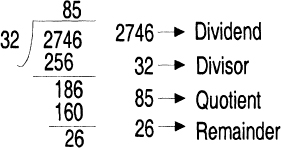6
Sequential Division
Unlike addition, subtraction and multiplication, division does not, in general, produce an exact answer, because the dividend is not necessarily a multiples of the divisor. A variety of division algorithms are to be described in the rest of this chapter.
6.1 SUBTRACT-AND-SHIFT APPROACH
Let's look at an example of pencil-and-paper division in Figure 6.1.
Here 2746 is referred to as the Dividend, 32 is the Divisor, 85 the Quotient and 26 the Remainder. After 274 – 256 is performed in the first step, 18 is obtained as a partial remainder. By pulling down 6, 18 becomes 180 (+6). On digital computers, most of the division operations are performed in a recursive procedure represented by the following formula:
![]()
where j = 0, 1, · · ·, n − 1 is the recursion index, R(j) is the partial remainder in the jth iteration. The initial partial remainder R(0) equals the dividend, and R(n) is the final remainder. The quotient is determined digit by digit in the recursive procedure, with qj+1 being the (j + 1)th quotient digit. D is the divisor, and r is the radix. In the above example r = 10.
From the recursion formula, we have


Fig. 6.1: Pencil-and-Paper Division
Let's look at ...
Get Arithmetic and Logic in Computer Systems now with the O’Reilly learning platform.
O’Reilly members experience books, live events, courses curated by job role, and more from O’Reilly and nearly 200 top publishers.

